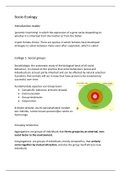Socio-Ecology
Introduction reader
‘genomic imprinting’ in which the expression of a gene varies depending on
whether it is inherited from the mother or from the father.
cryptic female choice: There are species in which females have developed
strategies to select between males even after copulation, which is called
College 1: Social groups
Sociobiologiy: the systematic study of the biological basis of all social
behaviour, it is based on the premise that some behaviours (social and
individual) are at least partly inherited and can be affected by natural selection
It predicts that animals will act in ways that have proven to be evolutionary
successful over time.
Fundamentale aspecten van Groep leven
• Conspecific tolerance, kritische afstand
• Communication
• Group tendencies
• Cooperation
Kritische afstand: vlucht-aanvalsafstand rondom
een individu, ruimte tussen persoonlijke ruimte en
homerange
Grouping tendencies
Aggregations are groups of individuals that forms groups by an external, non-
social factor in the environment.
Congregations: are groups of individuals, mostly conspecifics, that actively
come together by mutual attraction, and also the group itself attracts new
individuals
,Passive aggregatie: toeval van samenscholing
→ bv waterstroom zorgt ervoor dat groep kwallen bij elkaaer drijven
Active aggregation: een omgevingsfactor is de aantrekkende factor
→ bv koeienvla trekt strontvliegen aan
Passive congregation:
• soortgenoot is de aantrekkende factor
• zonder speciale interacties or individuele herkenning
• elk individu heeft toegang
→ bv school spreeuwen of groep flamingo’s
Active/social congregation: individuals recognize and interact with each other
→ bv kudde paarden of olifanten
Eusocialiteit: individuals are the (sterile) offspring of a reproductive cast,
forming a colony, and are strongly cooperative
→ bv minigarnaaltjes, naakte molratten en mieren
,College 2: Sex allocation (toewijzing and dispersal
Sex ratio= number
Sex allocation= investment in males and females
ESS: Evolutionary Stable Strategy, strategie binnen een populatie die niet door
een andere strategie kan worden overgenomen aangezien de ESS de hoogste
fitness heeft
Fisher investment sex ratio
Seks ratio mens is 1:1
• Niet door toeval, maar doordat het een frequency-depended ESS is
Ratio afhankelijk van de kosten om een nageslacht van bepaald geslacht
→ Bv. Vrouw 2 keer zo duur om te maken, ESS ratio komt uit op 2 keer zoveel
mannen
Fisher’s investment sex ratio determined by:
• Costs to produce female or male offspring
• Relatedness with offspring (shared genes, mostly 0.5)
• Mating success, depending on number of females and males in the
population (male can mate more often, female mates only once)
‘Rare sex has higher fitness’ (till you reach balance of course)
, If there is difference in fitness return by producing females or males
→ deviations of Sex Allocation 1:1
When?
• Local mate competition, -enhancement
• Local resource competition, -enhancement
• Maternal condition, mate attractiveness
Local mate competition:
• Bijv bij sluipwespen
• Larve gelegd in vliegenpop, mannetjes komen eerder uit dan vrouwtjes,
concurreren met elkaar, bevruchting vindt ter plekke plaats, vrouwtjes
vliegen weg om nieuwe vliegenpop te vinden
• In principe, concurreren broers met elkaar om zussen, echter dmv een
speciale manier van seks determinatie is er geen inteelt
• Vrouwelijk nageslacht levert hoogste fitness op, dus meer dochters
• Female biased seks ratio
• Competitie tussen verwante mannen voor de paring van de vrouwen
Local mate competition: Superparasitism; een 2e vrouwtje parasiteert de host,
vliegenpop wordt 2e keer geparasiteerd (hierbij krijg je dus mannetjes die niet
aan elkaar verwant zijn)
→ what will be the sex ratio
• Concurrentie tussen niet verwante mannetjes
• Dus 2e vrouwtje moet meerdere mannetjes produceren
om de kans op bevruchting door eigen nageslacht van de
vrouwtjes die uitkomen te vergroten
→ verschuiving meer male biased seks ratio richting 1:1
Local mate enhancement: verandering van seks ratio die te maken heeft met
parings mogelijkheden
• Bijv Leeuwen, meerdere mannetjes (meestal broers) kunnen samen
groepen vrouwtjes controleren ondanks de hoge kosten van competitie
• Vrouw in grote groep→ voordelig meer mannen produceren, die hebben
kans om troep leeuwinnen over te nemen





